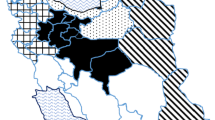Summary
This paper examines the relationship between rate of return to education and income distribution with the help of cross-nation data on 30 developing and developed countries. The results indicate that the higher income groups in the society benefit the higher the rate of return to any level of education, and the bottom 40 percent and the middle 40 percent income groups lose; and the disadvantage for the poor income groups is the least at the primary level of education. As higher rates of return to education suggest higher levels of income inequalities, rapid expansion of the education system may reduce income inequalities through decline in rates of return to education. Secondly, it is also argued here that since high income groups benefit from all levels of education, education investments targeted specifically towards the poor may be preferred to overall investment in education.
Similar content being viewed by others
References
Bhagwati, Jagdish, ‘Education, Class Structure and Income Equality,’World Development, 1 (1973), pp. 21–36.
Carnoy, Martin, Henry Levin, R. Nugent, S. Summa, C. Torres and J. Unsicker, ‘The Political Economy of Financing Education in Developing Countries,’ in:Financing Educational Development, International Development Research Centre, Ottawa, 1972, pp. 39–86.
Chenery, Hollis B., and M. Syrquin,Patterns of Development 1950-1970, New York, Oxford for the World Bank, 1975.
Chenery, H.B., M.S. Ahluwalia, C.L.G. Bell, J.H. Duloy and R. Jolly,Redistribution with Growth, London, Oxford for the World Bank, 1974.
Fields, Gary S., ‘Assessing Progress toward Greater Equality of Income Distribution,’ in: William P. McGreevey (ed.),Third World Poverty: New Strategies for Measuring Development Progress, Lexington, Mass., 1980, pp. 47–81.
Guisinger, Stephen E., James W. Henderson and Gerald W. Scully, ‘Earnings, Rates of Return to Education and the Earnings Distribution in Pakistan,’Economics of Education Review, 3 (1984), pp. 257–267.
Kuznets, Simon, ‘Economic Growth and Income Inequality,’American Economic Review, 45 (1955), pp. 1–28.
Kuznets, S., ‘Quantitative Aspects of Economic Growth of Nations III: Distribution of Income by Size,’Economic Development and Cultural Change, 11, Part II (1963), pp. 1–80.
Lecaillon, Jacques, Felix Paukert, Christian Morrissonand Dimitry Germidis,Income Distribution and Economic Development: An Analytical Survey, International Labour Office, Geneva, 1984.
Mathur, Gautam, ‘Financial Allocation to the Educational Sector: Some Considerations,’Journal of University Education, 5 (1966), pp. 73–83.
Paukert, Felix, ‘Income Distribution at Different Levels of Development: A Survey of Evidence,’International Labour Review, 108 (1973), pp. 97–125.
Psacharopoulos, George, ‘Returns to Education: A Further International Update and Implications,’Journal of Human Resources, 20 (1985), pp. 584–604. [World Bank Reprint Series: No. 362, Washington D.C.].
Psacharopoulos, G., and Maureen Woodhall,Education for Development, New York, Oxford for the World Bank, 1985.
Schultz, Theodore W., ‘Rate of Return in Allocating Investment Resources to Education,’Journal of Human Resources, 2 (1967), pp. 293–309.
Schultz, T.W., ‘The Noble Lecture: The Economics of Being Poor,’Journal of Political Economy, 88 (1980), pp. 639–651.
Tilak, Jandhyala B.G.,Economics of Inequality in Education, Sage Publications for the Institute of Economic Growth, New Delhi, 1987.
Tilak, J.B.G.,Education, and its Relation to Economic Growth, Poverty and Income Distribution: Past Evidence and Further Analysis, World Bank Discussion Paper No. 46, Washington D.C., 1989.
Tinbergen, Jan, ‘The Impact of Education on Income Distribution,’Review of Income and Wealth, 18 (1972), pp. 255–265.
World Bank,Poverty and Human Development, Washington D.C., 1980.
Author information
Authors and Affiliations
Additional information
The author is Consultant, the World Bank, Washington D.C., 20433 (USA), while on leave from the National Institute of Educational Planning and Administration, New Delhi. The incisive comments of George Psacharopoulos, Rati Ram, and the Editor(s) of this Journal on earlier versions of this study are gratefully acknowledged. However, the views expressed here and the errors that remain are the responsibility of the author alone and should not necessarily be attributed to anyone else, including the World Bank.
Rights and permissions
About this article
Cite this article
Tilak, J.B.G. Rates of return to education and income distribution. De Economist 137, 454–465 (1989). https://doi.org/10.1007/BF01705975
Issue Date:
DOI: https://doi.org/10.1007/BF01705975




